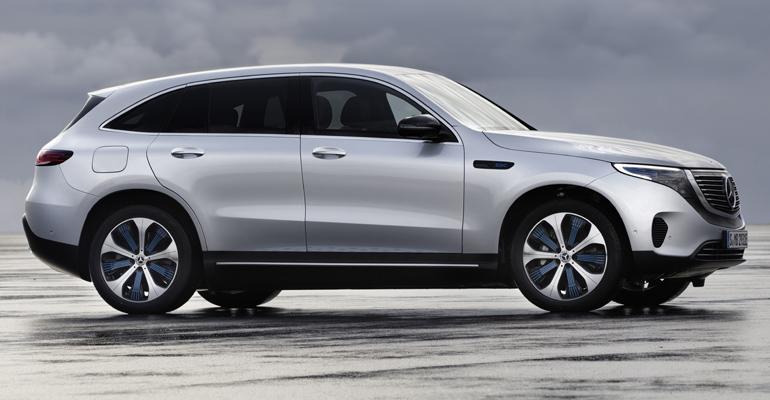Mercedes-Benz reveals the first of up to 10 new all-electric models currently under development at its engineering headquarters in Germany and planned for sale before the end of 2025 with the unveiling of its eagerly awaited EQ C.
A key rival to the newly introduced Jaguar I-Pace, soon-to-be-revealed Audi e-Tron Quattro and an upcoming production version of the BMW iX3 concept, the new 5-seat SUV is the first electric-powered Mercedes-Benz model put into series production, following the limited-volume B-Class Electric Drive and SLS Electric Drive.
According to Mercedes-Benz, it boasts a combined 402 hp and claimed 280-mile (451-km) range in initial EQ C 400 guise under Europe’s soon-to-be-superseded NEDC test procedure.
The 4-wheel-drive EQ C, which also will compete against the Tesla Model X, is based on the existing GLC alongside which it will be produced. However, changes to its platform accommodate a new electric drivetrain, battery and added side-impact crash protection.
Stylistically, the new Mercedes-Benz model leans heavily on the early Generation EQ concept revealed at the Paris auto show in 2016. The definitive production car, set for North American delivery in 2019, retains the same basic shape and 5-door layout of the concept, albeit with altered detailing.
Key design elements include a signature-look front end to be adopted on all dedicated EQ models. It features a conventional grille in place of the distinctive black-panel treatment used on the concept, although the shape of the headlamps and other cues, including the smooth-surfaced bumper treatment, are retained to give the new model a more modern appearance than any current Mercedes-Benz SUV.
Mercedes-Benz has focused on refining the EQ C’s aerodynamic qualities. While official figures are yet to be revealed, WardsAuto understands it achieves a drag coefficient below 0.30, due in part to its minimal ground clearance, flat underbody and wind-cheating wheel design.
At 187.4 ins. (4,760 mm) in length, 74.2 ins. (1,885 mm) in width and 52.1 ins. (1,323 mm) in height, the EQ C is 4.1 ins. (104 mm) longer, 0.2 in. (5 mm) narrower and a considerable 12.4 ins. (315 mm) lower than the GLC, with which it shares its 113.1-in. (2,873-mm) wheelbase.
Inside, the new Mercedes-Benz model uses an upgraded version of the GLC’s cabin, parts of which are to appear on a facelifted version of the midrange SUV due in 2019, including a redesigned dashboard with digital instrument and infotainment panels, reworked vents and a new multifunction steering wheel featuring touch pads within the horizontal spokes.
The EQ C has 2.8 cu.-ft. (79 L) more cargo capacity than the GLC at 17.7 cu.-ft. (501 L).
The electric SUV comes equipped with many of Mercedes-Benz’s latest driver-assistance systems, including a new predictive-speed adjustment function programmed to regulate the EQ C’s speed when approaching a traffic jam based on information from the navigation.
The EQ C is powered by a newly developed electric drivetrain (below, left) also earmarked for other new models from the newly formed Mercedes-Benz sub-brand, including a forthcoming entry-level EQ A hatchback and EQ S sedan flagship.
Initially previewed in the Generation EQ concept, it consists of two electric motors – one powering the front wheels, another driving the rear wheels – giving it 4-wheel-drive capability, depending on driving mode. Their combined output is 402 hp and 564 lb.-ft. (765 Nm) of torque.
By comparison, the Jaguar I-Pace’s two electric motors deliver a combined 395 hp and 513 lb.-ft. (696 Nm).
Each of the EQ C’s motors is configured differently: the one up front is tuned specifically for efficiency in the low-to-mid load range, while the rear motor is more performance-oriented with greater emphasis on the mid-to-high load range.
There are five driving modes: Comfort, Eco, Max Range, Sport and Individual. Paddles behind the steering wheel let the driver vary the amount of energy being recuperated during braking and coasting.
In Sport mode, Mercedes-Benz says the EQ C will accelerate from 0-to-62 mph (100 km/h) in 5.1 seconds. Top speed is limited to 112 mph (180 km/h). The German automaker quotes a towing capacity of 3,968 lbs. (1,801 kg) and 1,135-lb. (515-kg) payload.
Energy to power the new SUV’s synchronous motors is stored in an 80kWh lithium-ion battery weighing 1,433 lbs. (650 kg), or almost 27% of the EQ C’s total curb weight.
 The EQ C’s claimed range of 280 miles can’t quite match the 336 miles (541 km) of the I-Pace, which features a larger 90kWh battery, under the same test conditions.
The EQ C’s claimed range of 280 miles can’t quite match the 336 miles (541 km) of the I-Pace, which features a larger 90kWh battery, under the same test conditions.
A standard 7.4-kW onboard charger enables AC charging via either regular mains or high-voltage public charging stations. Under DC charging, the EQ C’s battery can be charged from 10% to 80% at up to 110kW in about 40 minutes, according to Mercedes-Benz’s figures.
The EQ C will be produced at both Mercedes-Benz’s Bremen plant in northern Germany and a joint venture factory operated with Chinese automaker BAIC in Beijing, although North American models are planned to hail exclusively from the former.
During development of its new electric model, Mercedes-Benz says it constructed over 200 prototypes and pre-production examples of the EQ C in a program claimed to have covered “several million kilometers across four continents.”





